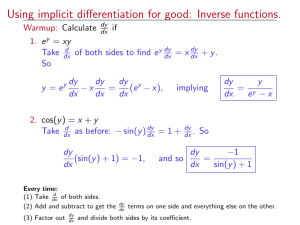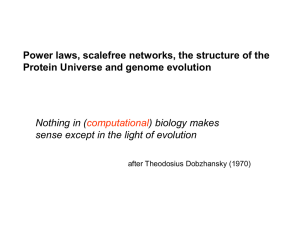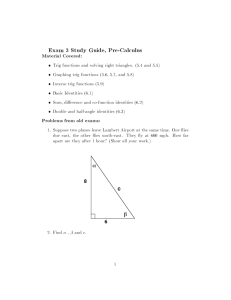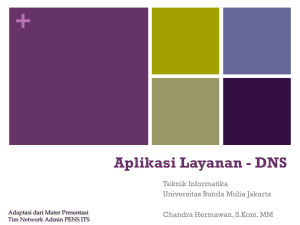Almost Condensed Domains Waseem Khalid and Shafiq Ur Rehman
advertisement
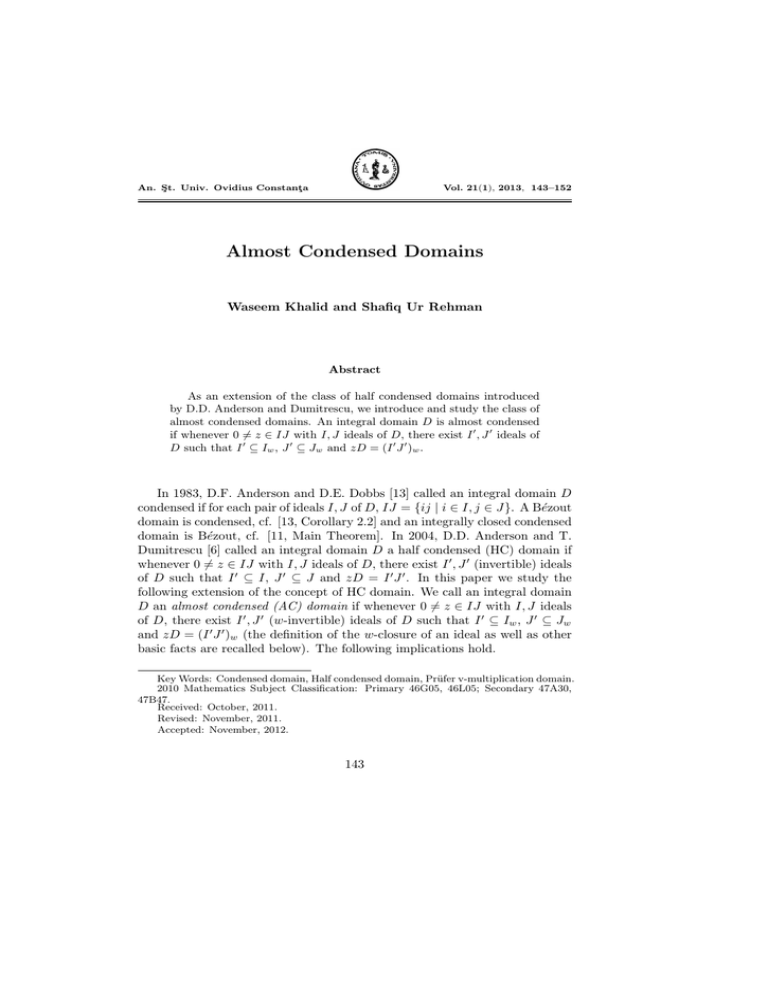
An. Şt. Univ. Ovidius Constanţa
Vol. 21(1), 2013, 143–152
Almost Condensed Domains
Waseem Khalid and Shafiq Ur Rehman
Abstract
As an extension of the class of half condensed domains introduced
by D.D. Anderson and Dumitrescu, we introduce and study the class of
almost condensed domains. An integral domain D is almost condensed
if whenever 0 ̸= z ∈ IJ with I, J ideals of D, there exist I ′ , J ′ ideals of
D such that I ′ ⊆ Iw , J ′ ⊆ Jw and zD = (I ′ J ′ )w .
In 1983, D.F. Anderson and D.E. Dobbs [13] called an integral domain D
condensed if for each pair of ideals I, J of D, IJ = {ij | i ∈ I, j ∈ J}. A Bézout
domain is condensed, cf. [13, Corollary 2.2] and an integrally closed condensed
domain is Bézout, cf. [11, Main Theorem]. In 2004, D.D. Anderson and T.
Dumitrescu [6] called an integral domain D a half condensed (HC) domain if
whenever 0 ̸= z ∈ IJ with I, J ideals of D, there exist I ′ , J ′ (invertible) ideals
of D such that I ′ ⊆ I, J ′ ⊆ J and zD = I ′ J ′ . In this paper we study the
following extension of the concept of HC domain. We call an integral domain
D an almost condensed (AC) domain if whenever 0 ̸= z ∈ IJ with I, J ideals
of D, there exist I ′ , J ′ (w-invertible) ideals of D such that I ′ ⊆ Iw , J ′ ⊆ Jw
and zD = (I ′ J ′ )w (the definition of the w-closure of an ideal as well as other
basic facts are recalled below). The following implications hold.
Key Words: Condensed domain, Half condensed domain, Prüfer v-multiplication domain.
2010 Mathematics Subject Classification: Primary 46G05, 46L05; Secondary 47A30,
47B47.
Received: October, 2011.
Revised: November, 2011.
Accepted: November, 2012.
143
144
Waseem Khalid and Shafiq Ur Rehman
Bézout domain
⇒1
⇓3
Condensed domain
Prüfer domain
⇒2
⇓4
⇒6
HC domain
PVMD
⇓5
⇒7
AC domain
The implications “1” and “2” are obvious, “3” is proved in [13, Corollary
2.2], “4” is proved in [6, Proposition 1.2], “5” is proved in Theorem 4 of this
paper and “6”, “7” are clear from definitions.
This new concept of AC domain depends upon the notion of star operation,
v-operation, t-operation and w-operation. A reader in need of a quick review
on this topic may consult sections 32 and 34 of Gilmer’s book [18]. For the
reader’s convenience we give a working introduction here for the notions involved. Let D be an integral domain with quotient field K and let F (D) denote
the set of nonzero fractional ideals of D. A function A 7→ A∗ : F (D) → F (D)
is called a star operation on D if ∗ satisfies the following three conditions for all
0 ̸= a ∈ K and for all I, J ∈ F (D): (1) D∗ = D and (aI)∗ = aI ∗ , (2) I ⊆ I ∗
and if I ⊆ J, then I ∗ ⊆ J ∗ , (3) (I ∗ )∗ = I ∗ . An ideal I ∈ F (D) is called a ∗ideal if I ∗ = I. For all I, J ∈ F (D), we have (IJ)∗ = (I ∗ J)∗ = (I ∗ J ∗ )∗ . These
equations define the so-called ∗-multiplication. If {Iα } is a subset of F (D)
such that ∑
∩Iα ̸= 0, then ∩Iα∗ is a ∗-ideal.∑Also, if {I
∑α } is a subset of F (D)
such that Iα is a fractional ideal, then ( Iα )∗ = ( Iα∗ )∗ . A star operation
∗ is said to be a stable star operation if (I ∩ J)∗ = I ∗ ∩ J ∗ for all I, J ∈ F (D).
The function ∗f : F (D) → F (D) given by I ∗f = ∪J ∗ , where J ranges over
all nonzero finitely generated sub-ideals of I, is also a star operation; ∗ is said
to be a star operation of finite character if ∗ = ∗f . Clearly (∗f )f = ∗f . Let
M ax∗ (D) denote the set of maximal ∗-ideals, that is, ideals maximal among
proper integral ∗-ideals of D. Every maximal ∗-ideal is a prime ideal. If ∗
is of finite character, then every proper ∗-ideal is contained in some maximal
∗-ideal, and ∗ is stable if and only if I ∗ = ∩P ∈M ax∗ (D) IDP for all I ∈ F (D),
cf. [1, Corollary 4.2]. A ∗-ideal I is of finite type if I = (a1 , ..., an )∗ for some
a1 , ..., an ∈ I. An ideal I ∈ F (D) is said to be ∗-invertible if (II −1 )∗ = D,
where I −1 = (D : I) = {x ∈ K | xI ⊆ D}. If ∗ is of finite character, then I is
∗-invertible if and only if II −1 is not contained in any maximal ∗-ideal of D;
in this case I ∗ = (a1 , ..., an )∗ for some a1 , ..., an ∈ I.
Let ∗1 , ∗2 be star operations on D. We write ∗1 ≤ ∗2 , if I ∗1 ⊆ I ∗2 for all
I ∈ F (D). In this case we get (I ∗1 )∗2 = I ∗2 = (I ∗2 )∗1 and every ∗1 -invertible
ideal is ∗2 -invertible. Some well-known star operations are: the d-operation
ALMOST CONDENSED DOMAINS
145
(given by I 7→ I), the v-operation (given by I 7→ Iv = (I −1 )−1 ) and the toperation (defined by t = vf ). The w-operation is the star operation given by
I 7→ Iw = {x ∈ K | Jx ⊆ I for some finitely generated ideal J of D with
J −1 = D}. The w-operation is a stable star operation of finite character. For
every I ∈ F (D), we have I ⊆ Iw ⊆ It ⊆ Iv ; so a v-ideal is a t-ideal and a
t-ideal is a w-ideal. It is known that M axw (D) = M axt (D), cf. [3, Corollary
2.17] and Iw = ∩P ∈M axt (D) IDP by [3, Corollary 2.13]. So, a nonzero fractional ideal is w-invertible if and only if it is t-invertible. Recall from [15] that
the quotient group of t-invertible t- fractional ideals modulo the subgroup of
principal fractional ideals is called the t-class group denoted by Clt (D).
Let ∗ be a finite character star operation on an integral domain D. Recall from [2] that D is called ∗-Noetherian if D satisfies the ascending chain
condition for ∗-ideals (equivalently, if for every ideal I there exists a finitely
generated ideal J ⊆ I with I ∗ = J ∗ ). For instance, the t-Noetherian domains
are the Mori domains.
A domain is independent of finite character F (or an F-IFC domain) if it
has a defining family F of primes that is independent and of finite character
[9]. An ideal I of a domain is called unidirectional if it belongs to a unique
member of the defining family F of primes [9]. A domain D is called a weakly
Matlis domain if the intersection D = ∩{DP | P ∈ M axt (D)} is independent
of finite character [10]. For an integral domain D, X 1 (D) will denote the set
of height-one prime ideals of D. A domain D is said to be a weakly Krull
domain if D is a locally finite intersection of its localizations at members of
X 1 (D). A domain D is called a Prüfer v-multiplication domain (PVMD) if
every nonzero finitely generated ideal of D is t-invertible [20].
Let D be an integral domain and I, J nonzero ideals of D. We say that
I, J is an almost condensed (AC) pair, if for each 0 ̸= z ∈ IJ, there exists
a pair I ′ , J ′ of (w-invertible) ideals of D such that I ′ ⊆ Iw , J ′ ⊆ Jw and
zD = (I ′ J ′ )w . We say that D is an almost condensed (AC) domain, if I, J
is an AC pair for all nonzero ideals I and J of D. If I or J is w-invertible
(equivalently t-invertible), then I, J is an AC pair (Remark 3). A domain D
is AC if and only if every pair of finitely generated ideals of D is AC. Hence
a PVMD is AC (Proposition 4). Since a Prüfer domain is a PVMD, studying
AC domains covers a vast area of commutative ring theory of interest. An HC
domain is clearly an AC domain. There exist simple examples of AC domains
which are not HC. For instance, the domain Z[X] is an AC domain but not
HC. In general a non-Prüfer PVMD is an AC domain which is not HC. We
show that every t-linked overring of an AC domain is AC (Proposition 2). If
D is an AC domain in which every maximal ideal is a t-ideal, then D is an HC
146
Waseem Khalid and Shafiq Ur Rehman
domain (Proposition 6). If D is an AC domain with Clt (D) = 0, then every
pair of w-ideals of D is condensed (Proposition 8). If D is an AC domain,
then DM is condensed for each M ∈ M axt (D) (Proposition 9). A domain
D is a PVMD if and only if it is integrally closed and AC (Proposition 10).
If D is an F-IFC domain such that DM is condensed for each M ∈ F, then
D is an AC domain (Proposition 12). A weakly Matlis domain D is an AC
domain if and only if DM is condensed for each M ∈ M axt (D) (Corollary 13).
A Noetherian domain D is an AC domain if and only if DM is condensed for
each M ∈ M axt (D) if and only if D is weakly Krull and DM is condensed
for each M ∈ X 1 (D) (Theorem 14). If {Di }i∈Λ is an ascending chain of AC
domains such that Di is t-linked over Dj for every Dj ⊆ Di , then D = ∪i∈Λ Di
is an AC domain (Proposition 15). If D is a Noetherian weakly Krull domain
whose integral closure D′ is two-generated as a D-module, then D[{Xλ }] is an
AC domain for every set of indeterminates {Xλ }λ∈Λ over D (Proposition 16).
Throughout this paper all rings are (commutative unitary) integral domains.
For a domain D, denote the complete integral closure by D̄ and the integral closure by D′ . Our standard reference for any undefined notation or
terminology is [18].
Recall that an extension R ⊆ T of domains is said to be t-linked if, whenever
J is a nonzero finitely generated ideal of R with J −1 = R, we have (JT )−1 = T .
Such extensions were introduced in [17]. In [6, Proposition 1.1], it is proved
that every overring of an HC domain is HC. In the next proposition, we shall
prove that a t-linked overring of an AC domain is AC. A lemma is in order.
Lemma 1. Let R ⊆ T be a t-linked extension of domains. Then (Iw T )w =
(IT )w for any nonzero ideal I of R.
Proof. Let y ∈ Iw . Then yA ⊆ I for some finitely generated ideal A with
A−1 = R. This implies that yAT ⊆ IT with (AT )−1 = T , because T is a
t-linked overring of R. Hence y ∈ (IT )w and thus Iw ⊆ (IT )w . This implies
that (Iw T )w ⊆ (IT )w . The opposite inclusion is clear.
Proposition 2. Let D be an AC domain and E a t-linked overring of D.
Then E is also an AC domain. In particular, every fraction ring of an AC
domain is AC.
Proof. Let I, J be two nonzero ideals of E and 0 ̸= z ∈ IJ. Then z =
x1 y1 + · · · + xn yn for some xi ∈ I and yi ∈ J. Let 0 ̸= d ∈ D such that
dxi , dyi ∈ D for all i. Then d2 z ∈ (dx1 D + · · · + dxn D)(dy1 D + · · · + dyn D).
Since D is AC, d2 zD = (I ′ J ′ )w for some ideals I ′ ⊆ (dx1 D + · · · + dxn D)w
and J ′ ⊆ (dy1 D + · · · + dyn D)w . Then I ′′ = I ′ /d ⊆ (x1 D + · · · + xn D)w ,
ALMOST CONDENSED DOMAINS
147
J ′′ = J ′ /d ⊆ (y1 D + · · · + yn D)w are fractional ideals of D and zD = (I ′′ J ′′ )w .
This implies that zE = (zE)w = ((I ′′ J ′′ )w E)w . Since E is t-linked, we get
that zE = (I ′′ J ′′ E)w = ((I ′′ E)(J ′′ E))w and I ′′ E ⊆ Iw E ⊆ (Iw E)w = (IE)w ,
J ′′ E ⊆ Jw E ⊆ (Jw E)w = (JE)w , cf. Lemma 1. The in particular statement
follows from [7, Proposition 2.3(3)].
Remark 3. Let D be a domain and I, J be nonzero ideals of D. If I or J is
w-invertible (equivalently t-invertible, cf. [3, Corollary 2.17]), then I, J is an
AC pair. Indeed, if J is w-invertible and 0 ̸= z ∈ IJ, then zD = ((zJ −1 )J)w
with zJ −1 ⊆ I ⊆ Iw .
Proposition 4. A domain D is an AC domain if and only if every pair of
finitely generated ideals of D is an AC pair. In particular, every PVMD is an
AC domain.
Proof. One implication is clear. For the converse, let I, J be an arbitrary pair
of ideals of D and 0 ̸= z ∈ IJ. Then z = i1 j1 + · · · + in jn , where ik ∈ I and
jk ∈ J for k = 1, ...., n. Then z ∈ I ′ J ′ , where the ideals I ′ and J ′ are given
by I ′ = (i1 , ...., in ) ⊆ I and J ′ = (j1 , ...., jn ) ⊆ J. By hypothesis, I ′ , J ′ is an
′
AC pair, so there exist ideals I ′′ ⊆ Iw
⊆ Iw and J ′′ ⊆ Jw′ ⊆ Jw such that
′′ ′′
zD = (I J )w . The “in particular” assertion follows from Remark 3 because
a nonzero fractional ideal is w-invertible if and only if it is t-invertible.
Example 5. Consider the domain D = F [[X 2 , X 3 ]] where F is a field. Then
by [13, Example 2.3], D is condensed domain and hence AC. Clearly D is not
PVMD because it is not integrally closed.
Proposition 6. Let D be an AC domain in which every maximal ideal is a
t-ideal. Then D is an HC domain.
Proof. If every maximal ideal is a t-ideal, then w = d, cf. [24, Proposition
2.2].
Example 7. Since a quasi-local HC domain is condensed [6], Proposition 6
shows that, a quasi-local one-dimensional domain is AC if and only if it is
condensed. So, the rings R + XR(Y, Z)[[X]] and R[[X 3 , X 5 , X 6 , X 8 , ...]] are
not AC, cf. [13, Example 2.11].
Proposition 8. Let D be an AC domain with Clt (D) = 0. Then every pair
of w-ideals of D is condensed.
Proof. Let I, J be a pair of w-ideals of D with 0 ̸= z ∈ IJ. Since D is AC, there
exist I ′ , J ′ (t-invertible) ideals of D such that I ′ ⊆ Iw = I, J ′ ⊆ Jw = J and
zD = (I ′ J ′ )w . As I ′ , J ′ are w-invertible and Clt (D) = 0, we get I ′ = xD and
J ′ = yD for some x ∈ I and y ∈ J. Then zD = ((xD)(yD))w = ((xy)D)w =
(xy)D implies z = xyu for some unit u. Thus D is condensed.
148
Waseem Khalid and Shafiq Ur Rehman
Proposition 9. Let D be an AC domain. Then DM is condensed for each
M ∈ M axt (D).
Proof. Let M ∈ M axt (D) and 0 ̸= z ∈ (IDM )(JDM ), where I, J are ideals
of D. Then sz ∈ IJ for some s ∈ D − M . Since D is AC, there exist
I ′ , J ′ ideals of D such that I ′ ⊆ Iw , J ′ ⊆ Jw and szD = (I ′ J ′ )w . Then
zDM = ((I ′ J ′ )w )DM = (I ′ J ′ )DM and I ′ DM ⊆ IDM , J ′ DM ⊆ JDM . As
I ′ DM and J ′ DM are principal, DM is condensed.
In [6, Proposition 1.2], it is shown that an integral domain is Prüfer if and
only if it is integrally closed and HC. We extend this result to AC domains.
Proposition 10. A domain D is a PVMD if and only if it is integrally closed
and an AC domain.
Proof. A PVMD is integrally closed (cf. [22, Theorem 3.5]) and by Proposition
4 it is an AC domain. Conversely, assume that D is integrally closed and an
AC domain. Then by Proposition 9, [11, Main Theorem] and [23, Theorem
63], DM is a valuation domain for each maximal t-ideal M of D. Hence D is
a PVMD, cf. [20, Theorem 5].
Corollary 11. The complete integral closure of an AC domain is a PVMD.
Proof. Let D be an AC domain. Then D̄ is t-linked by [7, Proposition 2.3(5)]
and integrally closed by [18, Theroem 13.1(2)]. Now apply Propositions 2 and
10.
Recall from [9] that a family F = {Pi }i∈L of nonzero
prime ideals of D
∩
is called a defining family of primes for D if D = i∈L DPi . If, further, every nonzero nonunit of D belongs to at most finitely many members of F, F
is of finite character, and if no two members of F contain a nonzero prime
ideal, F is independent. An ideal I of a domain is called unidirectional if it
belongs to a unique member of the defining family F of primes. An integral
domain D is independent of finite character F (or an F-IFC-domain) if it has
a defining family F of primes that is independent and of finite character. The
corresponding family {DPi }i∈L ∩
of overrings of D induces a star operation ∗F
on D defined by I 7−→ I ∗F = i∈L IDPi for all I ∈ F (D). We shall often
refer to ∗F as the star operation induced by F. By [3, Corollary 2.13] and [9,
Proposition 3.2], I ∗F ⊆ Iw .
Proposition 12. Let D be an F-IFC domain such that DM is condensed for
each M ∈ F. Then D is an AC domain.
ALMOST CONDENSED DOMAINS
149
Proof. Let I, J be nonzero ideals of D. Let 0 ̸= x ∈ IJ and let M1 , ..., Mn be
the members of F containing x. Since IDMi , JDMi is a condensed pair, x =
ai bi for some ai ∈ IDMi and bi ∈ JDMi . Hence xDMi = (Ai )Mi (Bi )Mi , where
Ai = ai DMi ∩ D and Bi = bi DMi ∩ D are unidirectional ideals with respect to
F or equal to D, cf. [9, Theorem 3.3]. Set A = A1 · · · An and B = B1 · · · Bn .
We have (AB)Mi = (Ai Bi )Mi = (xD)Mi . Also (AB)DM = DM = xDM for
each M in F distinct from M1 , ..., Mn . It follows that (AB)∗F = (xD)∗F = xD
and hence xD = (AB)w with A ⊆ I ∗F ⊆ Iw and B ⊆ J ∗F ⊆ Jw .
Recall from [10], that a domain D is called a weakly Matlis domain if the
intersection D = ∩{DP | P ∈ M axt (D)} is independent of finite character.
Corollary 13. Let D be a weakly Matlis domain. Then D is an AC domain
if and only if DM is condensed for each M ∈ M axt (D).
Proof. Apply Proposition 12 and 9.
Theorem 14. Let D be a Noetherian domain. Then the following are equivalent:
(1) D is an AC domain.
(2) DM is condensed for each M ∈ M axt (D).
(3) D is weakly Krull and DM is condensed for each M ∈ X 1 (D).
Proof. (1) ⇒ (2). Apply Proposition 9.
(2) ⇒ (3). As D is a Mori domain, the intersection D = ∩M ∈M axt (D) DM
has finite character, cf. [14, Theorem 3.3]. Also every maximal t-ideal M
of D has height one. Indeed, if ht(M ) > 1, then ht(M DM ) > 1 which is a
contradiction because a Noetherian condensed domain has dimension at most
one, cf. [13, Corollary 2.9]. Thus M axt (D) = X 1 (D) and we are done.
(3) ⇒ (1). By [8, Lemma 2.1], every maximal t-ideal has height one. So D
is an F-IFC domain with F = X 1 (D). Hence by Proposition 12, D is an AC
domain.
Proposition 15. Let {Di }i∈Λ be an ascending chain of AC domains such
that each Di is t-linked over Dj for Dj ⊆ Di . Then D = ∪i∈Λ Di is an AC
domain.
Proof. Let I, J be two nonzero ideals of D with 0 ̸= z ∈ IJ. Then z =
x1 y1 + · · · + xn yn , where xk ∈ I and yk ∈ J for k = 1, ...., n. There exist
i0 ∈ Λ such that Di0 contains all elements xi , yj and so z ∈ Di0 . Let I ′ =
x1 Dio + · · · + xn Dio and J ′ = y1 Dio + · · · + yn Dio . Then z ∈ I ′ J ′ . As Di0 is
′
an AC domain, zDi0 = (I ′′ J ′′ )w for some ideals I ′′ ⊆ Iw
and J ′′ ⊆ Jw′ . Since
D is t-linked over Di0 (cf. [7, Proposition 2.3(1)]), zD = ((I ′′ J ′′ )w D)w =
(I ′′ J ′′ D)w = ((I ′′ D)(J ′′ D))w and I ′′ D ⊆ (I ′ D)w ⊆ Iw , J ′′ D ⊆ (J ′ D)w ⊆ Jw ,
cf. Lemma 1.
150
Waseem Khalid and Shafiq Ur Rehman
A domain D is said to have the two-generator property or simply is twogenerated if every ideal of D is generated by two elements.
Proposition 16. Let D be a Noetherian weakly Krull domain whose integral
closure D′ is two-generated as a D-module. Then D[{Xλ }] is an AC domain
for every set of indeterminates {Xλ }λ∈Λ over D.
Proof. Since a polynomial extension is t-linked [22, Corollary 2.3], we can
assume that {Xλ }λ∈Λ is finite, cf. Proposition 15. By induction, on the
cardinality of Λ, we can assume that {Xλ }λ∈Λ has a single indeterminate X.
The domain D[X] is a Noetherian weakly Krull domain (cf. [7, Corollary
4.12]) and D′ [X] is two-generated as a D[X]-module. Let P be a height-one
prime ideal of D[X]. By using (a) ⇔ (c) in [19, Theorem 2.3], D[X]P is twogenerated and by [6, Corollary 1.5] it is condensed. By Theorem 14, D[X] is
an AC domain.
Example 17. Let A ⊂ B be an extension of DVRs such that BA−{0} is a field,
qf (A)∩B = A and B is two-generated as an A-module. Then D = A+XB[X]
is an AC domain. Indeed, D is a Noetherian weakly Krull domain (see [12,
Theorem 3.4]) and D′ = B[X] is two-generated as a D-module. In particular,
the domain R[[X]] + Y C[[X]][Y ] is an AC domain.
Remark 18. A domain D is PVMD if and only if D[X] is PVMD, cf. [22,
Theorem 3.7]. Therefore an integrally closed domain D is AC if and only
D[X] is AC, cf. Proposition 10.
Recall from [18, Section 33] that the Nagata ring D(X) of a domain D is the
fraction ring of D[X] with respect to the multiplicative set S of polynomials
whose coefficients generate the unit ideal. Our final example shows that if D
is a Noetherian AC domain, then D[X] need not be an AC domain.
Example 19. Let B be the field of all complex numbers which can be constructed by straight-edge
and compass from 0 and 1 (see [21, page 210]). Let
√
D = B + XB( 3 3)[[X]]. Then
√ D is a local condensed domain (see [4, Example 2.11]) and D′ = B( 3 3)[[X]] is a DVR which is finite over D. The
domain D[Y
√] is a Noetherian weakly Krull domain, cf. [12, Theorem 3.4]. Let
M = XB( 3 3)[[X]]. Then D[Y ]M [Y ] = D(Y ). The ring D(Y ) is a local ring
with residue field B(Y ). Also the integral closure of D(Y ) is D′ (Y ) (see [18,
Exercise 2, p. 415])√which is a DVR
√ and is finite over D(Y ). The residue
field of D′ (Y ) is B( 3 3)(Y ) and [B( 3 3)(Y ) : B(Y )] = 3 . Note that Z 2 − Y
is a quadratic polynomial in B(Y )[Z] which does not split in B(Y ). By [5,
Theorem 5], D(Y ) is not condensed and hence D[Y ] is not AC, cf. Theorem
14.
ALMOST CONDENSED DOMAINS
151
Acknowledgements. We would like to express our sincere thanks to
Abdus Salam School of Mathematical Sciences, GC University Lahore and
HEC(Higher Education Commission of Pakistan) for their support in this research work. We thank Professor Muhammad Zafrullah who read an earlier
version of this paper and sent us useful comments. Our sincere thanks to
Tiberiu Dumitrescu for many useful email discussions. We also appreciate the
valuable suggestions and changes recommended by the referees.
References
[1] D.D. Anderson, Star-operations induced by overrings, Comm. Algebra 16
(1988), 2535-2553.
[2] D.D. Anderson and D.F. Anderson, Some remarks on star operations and
the class group, J. Pure Appl. Algebra 51 (1988), 27-33.
[3] D.D. Anderson and S.J. Cook, Two star operations and their induced
latices, 28 (2000), 2461-2475
[4] D.D. Anderson and T. Dumitrescu, Condensed domains, Canad. Math.
Bull. 46 (2003), 3-13.
[5] D.D. Anderson and T. Dumitrescu, Condensed local domains which are
not strongly condensed, Math. Rep. 55 (2003), 205-209.
[6] D.D. Anderson and T. Dumitrescu, Half condensed domains, Houston J.
Math. 30 (2004), 929-936.
[7] D.D. Anderson, E.G. Houston, M. Zafrullah, t-linked extensions, the tclass group, and Nagata’s theorem, J. Pure Appl. Algebra 86 (1993),
109-124.
[8] D.D. Anderson, J. L. Mott and M. Zafrullah, Finite character representation of integral domains, Bollettino U.M.I. 76-B (1992), 613-630.
[9] D.D. Anderson and M. Zafrullah, Independent locally-finite intersections
of localizations, Houston J. Math. 25 (1999), 433-452.
[10] D.D. Anderson and M. Zafrullah, Splitting sets and weakly Matlis domains, Proceedings of the Fifth International Fez Conference on Commutative Algebra and its Applictions, Fez, Morocco, 2008.
[11] D.F. Anderson, J.T. Arnold and D.E. Dobbs, Integrally closed condensed
domains are Bézout, Canad. Math. Bull. 28 (1985), 98-102.
152
Waseem Khalid and Shafiq Ur Rehman
[12] D.F. Anderson, G.W. Chang, A.J. Park, Weakly Krull and related domains of the form D + M, A + XB[X], A + X 2 B[X], Rocky Mountain J.
Math. 36(2006), 1-22.
[13] D.F. Anderson and D.E. Dobbs, On the product of ideals, Canad. Math.
Bull. 26 (1983), 106-114.
[14] V. Barucci, Mori domains, Non-Noetherian Commutative Ring Theory
(S.C Chapman and S. Glaz Editors), Math. Appl. Kluwer Acad. Publ.
Dordrecht, 520(2000), 57-73.
[15] A. Bouvier and M. Zafrullah, On some class group of an integral domain,
Bull. Soc. Math. Greece 29 (1988), 45-59.
[16] G.W. Chang, Strong Mori domains and the ring D[x]Nv , J. Pure Appl.
Algebra 197 (2005), 3669-3686.
[17] D. Dobbs, E. Houston, T. Lucas, M. Zafrullah, t-Linked overrings and
Prüfer v-multiplication domains, Comm. Algebra 17 (1989) 28352852.
[18] R. Gilmer, Multiplicative Ideal Theory, Marcel Dekker, New York, 1972.
[19] C. Greither, On the two generator problem for the ideal of a onedimensional ring, J. Pure Appl. Algebra 24 (1982), 265-276.
[20] M. Griffin, Some results on v-multiplications rings, Canad. J. Math. 19
(1967), 710-722.
[21] N. Jacobson, Basic Algebra I, Freeman, San Francisco, 1974.
[22] B.G. Kang, Prüfer v-multiplication domains and the ring R[X]Nv , J. Algebra 123 (1989), 151-170.
[23] I. Kaplansky, Commutative Rings, Revised Edition, The University of
Chicago Press, Chicago and London, 1974.
[24] A. Mimouni, Integral domains in which each ideal is a w-ideal, Comm.
Alg. 33(2005), 1345-1355.
Waseem Khalid,
Department of Mathematics,
Govt. College University,
Faisalabad, Pakistan.
Email: wsmkhld@yahoo.com
Shafiq Ur Rehman,
Department of Mathematics,
COMSATS Institute of Information Technology,
Attock, Pakistan.
Email: shafiq ur rahman2@yahoo.com
